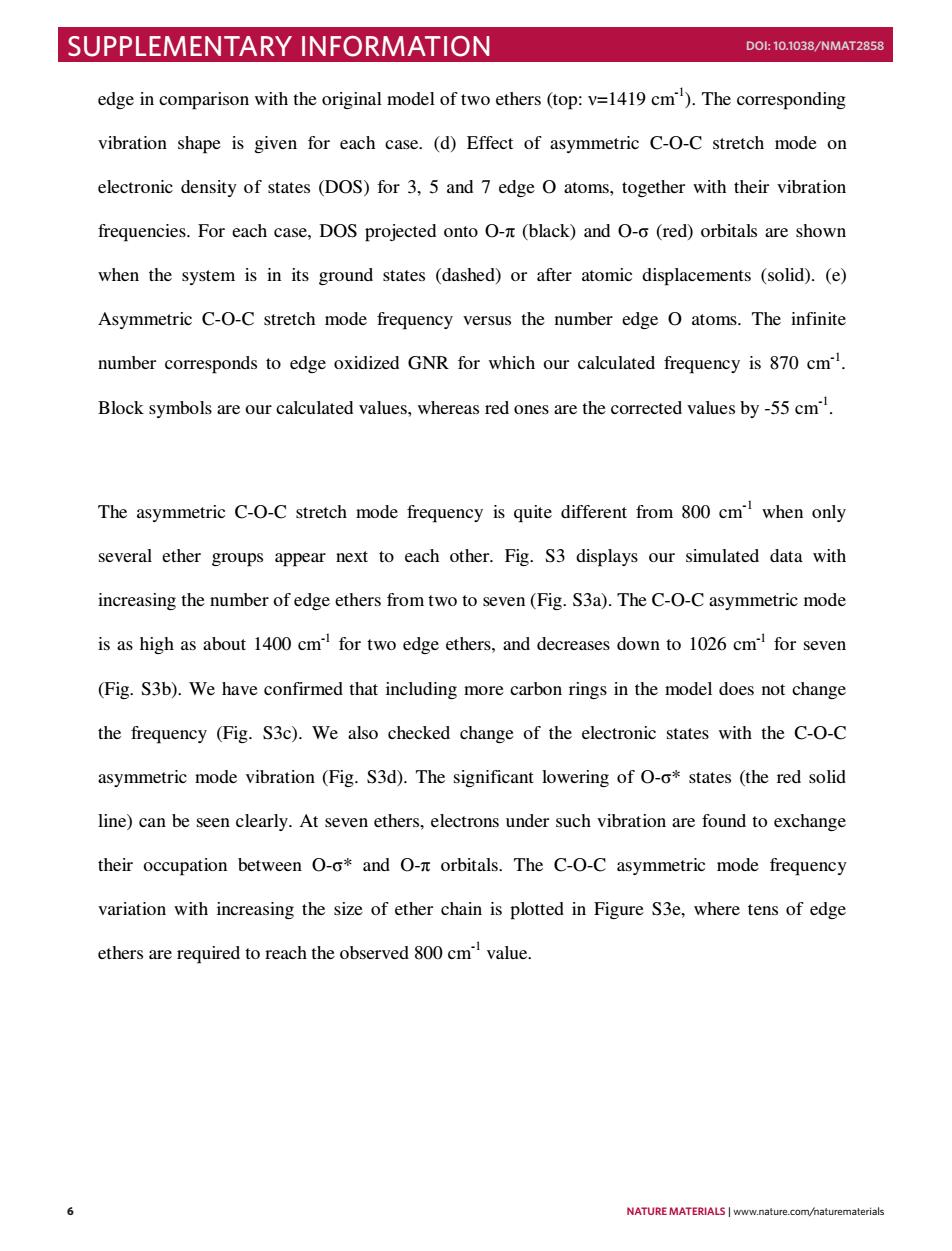正在加载图片...

SUPPLEMENTARY INFORMATION D0:10.1038/NMAT2858 edge in comparison with the original model of two ethers(top:v=1419 cm).The corresponding vibration shape is given for each case.(d)Effect of asymmetric C-O-C stretch mode on electronic density of states (DOS)for 3,5 and 7 edge O atoms,together with their vibration frequencies.For each case,DOS projected onto O-t(black)and O-0(red)orbitals are shown when the system is in its ground states (dashed)or after atomic displacements (solid).(e) Asymmetric C-O-C stretch mode frequency versus the number edge O atoms.The infinite number corresponds to edge oxidized GNR for which our calculated frequency is 870 cm. Block symbols are our calculated values,whereas red ones are the corrected values by-55 cm. The asymmetric C-O-C stretch mode frequency is quite different from 800 cm when only several ether groups appear next to each other.Fig.S3 displays our simulated data with increasing the number of edge ethers from two to seven (Fig.S3a).The C-O-C asymmetric mode is as high as about 1400 cm for two edge ethers,and decreases down to 1026 cm for seven (Fig.S3b).We have confirmed that including more carbon rings in the model does not change the frequency (Fig.S3c).We also checked change of the electronic states with the C-O-C asymmetric mode vibration (Fig.S3d).The significant lowering of O-o*states (the red solid line)can be seen clearly.At seven ethers,electrons under such vibration are found to exchange their occupation between O-o*and O-m orbitals.The C-O-C asymmetric mode frequency variation with increasing the size of ether chain is plotted in Figure S3e,where tens of edge ethers are required to reach the observed 800 cm value. 6 NATURE MATERIALS www.nature.com/naturematerials6 nature MATERIALS | www.nature.com/naturematerials supplementary information doi: 10.1038/nmat2858 6 edge in comparison with the original model of two ethers (top: ν=1419 cm-1). The corresponding vibration shape is given for each case. (d) Effect of asymmetric C-O-C stretch mode on electronic density of states (DOS) for 3, 5 and 7 edge O atoms, together with their vibration frequencies. For each case, DOS projected onto O-π (black) and O-σ (red) orbitals are shown when the system is in its ground states (dashed) or after atomic displacements (solid). (e) Asymmetric C-O-C stretch mode frequency versus the number edge O atoms. The infinite number corresponds to edge oxidized GNR for which our calculated frequency is 870 cm-1. Block symbols are our calculated values, whereas red ones are the corrected values by -55 cm-1. The asymmetric C-O-C stretch mode frequency is quite different from 800 cm-1 when only several ether groups appear next to each other. Fig. S3 displays our simulated data with increasing the number of edge ethers from two to seven (Fig. S3a). The C-O-C asymmetric mode is as high as about 1400 cm-1 for two edge ethers, and decreases down to 1026 cm-1 for seven (Fig. S3b). We have confirmed that including more carbon rings in the model does not change the frequency (Fig. S3c). We also checked change of the electronic states with the C-O-C asymmetric mode vibration (Fig. S3d). The significant lowering of O-σ* states (the red solid line) can be seen clearly. At seven ethers, electrons under such vibration are found to exchange their occupation between O-σ* and O-π orbitals. The C-O-C asymmetric mode frequency variation with increasing the size of ether chain is plotted in Figure S3e, where tens of edge ethers are required to reach the observed 800 cm-1 value